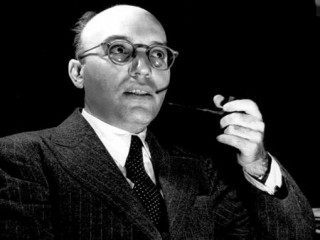
Kurt Weill biography
Date of birth : 1900-03-02
Date of death : 1950-04-03
Birthplace : Dessau, Germany
Nationality : German-American
Category : Famous Figures
Last modified : 2011-09-09
Credited as : opera composer, ,
The operas and other stage works of Kurt Weill, German-American composer, had considerable influence on contemporary Western musical theater.
Kurt Weill was born in Dessau, Germany, on March 2, 1900. He studied piano as a child and composed several works before enrolling at the Berlin Hochschule fur Musik at age 18. He left to work in provincial opera houses, returning to Berlin to study with Ferruccio Busoni from 1921 to 1924.
Weill's early compositions were largely instrumental concert works written in the current "advanced" style, but in 1926 he composed a one-act opera, Der Protagonist (The Protagonist; libretto by Georg Kaiser), and concentrated henceforth on stage works. Two short operas containing elements of popular music followed: Royal Palace (1926; by Kaiser) and Der Zar lasst sich photographieren (1927, The Czar Has His Photograph Taken; by Ivan Goll).
As a composer, Weill achieved maturity in his collaboration with the poet-playwright Bertolt Brecht. On the eve of the Nazi victory in Germany, the team produced thinly veiled attacks on status-quo social attitudes and corrupt politics. Weill's music—trenchant, ironic, bittersweet— was the perfect setting for Brecht's pessimistic texts. Die Dreigroschenoper (1928, The Threepenny Opera) is their most famous work. This play with music, starring Lotte Lenya (Weill's young bride), was an immediate sensation and was performed throughout Europe. An English-language revival in 1955 ran for over 2, 000 performances.
Other Weill-Brecht stage works included the opera Aufstieg und Fall der Stadt Mahagonny (1927-1929, The Rise and Fall of the City of Mahagonny), the musical play Happy End (1929), and the school opera Der Jasager (1930, The Yes-sayer). With other librettists Weill composed the operas Die Burgschaft (1930, The Pledge) and Der Silbersee (1932, The Silver Lake) before his works were banned by the Hitler regime and he fled Berlin in February 1933.
Weill lived briefly in Paris and London. His last collaboration with Brecht was an unusual ballet with songs, Die Sieben Todtsunden (1933, The Seven Deadly Sins), with choreography by George Balanchine, and he composed the scores for two musical plays, Marie Galante (1934) and A Kingdom for a Cow (1934). He became a naturalized American citizen in 1936.
The larger American compositions of Weill comprise 10 stage works, including the operas Street Scene (1946; by Elmer Rice and Langston Hughes) and Down in the Valley (1948; by Arnold Sundgaard); the musicals Johnny Johnson (1936; by Paul Green), Knickerbocker Holiday (1938; by Maxwell Anderson), Lady in the Dark (1940; by Moss Hart); and the "musical tragedy" Lost in the Stars (1949; by Anderson).
Weill was a creative genius, an innovator worthy of considerable study, whose music always bears unique stylistic traits of melody, harmony, rhythm, and orchestral color. His best stage works contain a sophistication of technique and a grasp of character delineation often belied by the use of simple means and "ordinary" elements from German folk tradition and the contemporary dance hall. As a whole, the works are innovative in their mixing of singing actors with opera singers, use of films and unconventional staging and design, and their explosive political and social content. Two Weill songs are worldwide popular standards: "Moritat" (or "Mack the Knife") from Threepenny Opera and "September Song" from Knickerbocker Holiday, both characteristic of his best work. He died on April 3, 1950.
Weill's career is recounted in David Ewen, European Light Opera (1962) and The World of Twentieth Century Music (1968). His work with Brecht is discussed in Frederick Ewen, Bertolt Brecht (1967).
















